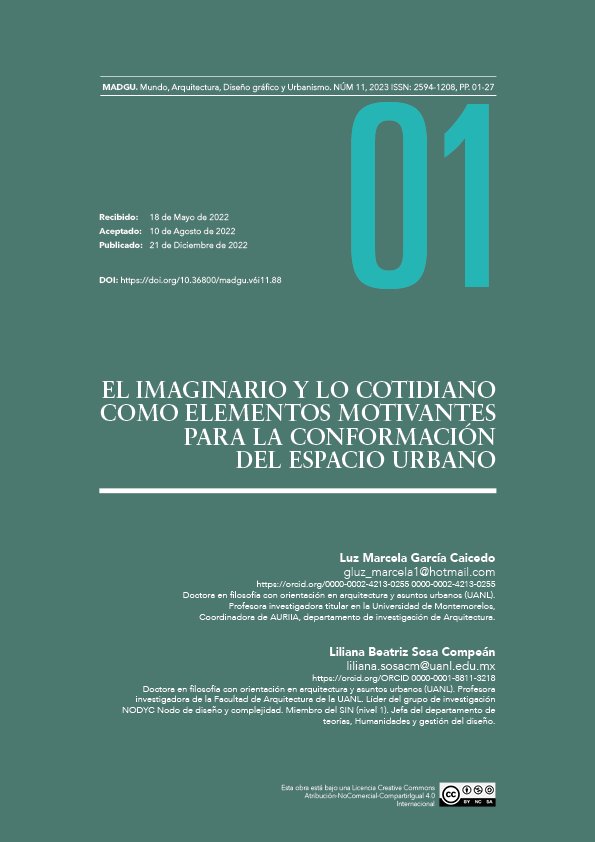The imaginary and the everyday as motivating elements for the conformation of the urban space
DOI:
https://doi.org/10.36800/madgu.v6i11.88Keywords:
Imaginaries, Everyday Life and urban space.Abstract
The imaginary as an intangible element present in society manifests itself as a fundamental component in the formation of the individual and the conformation of the collective. The operational forms developed by him, within a city such as everyday life, can be altered by the social imaginary contained in its context, to the point of breaking their daily narratives. This relationship is fundamental, since it is part of the development of the individual in his current future, and his participation in the constructed scenarios and his future projection. Under these theoretical foundations, a deductive conceptual analysis is developed in this article through a bibliographic review of imaginaries and everyday life, with the aim of establishing theoretical positions to support design projects aimed at recognizing these themes, for the resolution of problems and evolution of urban contexts. From this bibliographic review, a case study will highlight the influence of the urban context and the imaginaries, in their daily development and future aspirations of individuals, as well as the possible actions in their urban context, all through observations and methodological analysis made from the storytelling tool.
Downloads
References
Bartra, R. (2006). Antropología del Cerebro. La conciencia y los sistemas simbólicos. México: FCE.
Beuchot, M. (2004). Hermenéutica, analogía y símbolo. México: Herder.
Carrasco Bonet, M. (2011). Alison Smithson, un acercamiento particular a la realidad urbana.
Carretero P. A., E. (2005). Imaginario y utopías. Athenea Digital, 40-60. DOI: https://doi.org/10.5565/rev/athenead/v1n7.180
Castells, M. (1972). Cuestión Urbana. París: España editores.
Castoriadis, C. (1983). La institución imaginaria de la sociedad Vol. I. Barcelona: Tusquets.
Château, J. (1976). Las fuentes de lo imaginario. Madrid: Fondo de Cultura Económica.
Chauchard, P. (1952). Précis de biologie humaine. París.
Cobas, A. (2022). MarketDataMéxico. Obtenido de https://www.marketdatamexico.com/es/static/home
Coca, J. R. (2011). Nuevas Posibilidades de los Imaginarios Sociales. La Codosera: Ceasga .
Durand, G. (1994). Lo Imaginario. Barcelona: Ediciones del Bronce.
Durkheim, É. (1990). Educación y sociología. Barcelona: Península.
García, C. L. (2017). Desarrollo de una población con índices de pobreza, usando estrategias basadas en sistemas complejos. San Nicolás de los Garza: UANL.
Heller, Ágnes. (1977). Sociología de la vida cotidiana. Barcelona: J. F. Yvars y E. Pérez Nadal (trads.).
Heller, Ágnes. (1985). Historia y vida cotidiana. México: Grijalbo, colecc. Enlace.
Heller, Ágnes. 2004. O cotidiano e a história. Carlos Nelson Coutinho y Leandro Konder (trads.). São Paulo: Paz e Terra.
Inegi. (2020). Cuéntame Inegi. Obtenido de https://www.cuentame.inegi.org.mx
Lalive D‘Epinay, C. (2008). La vida cotidiana: Construcción de un concepto sociológico y antropológico. Sociedad hoy.
Lefebvre, H. (1968). Derecho a la ciudad. Madrid: Capitán Swing Libros.
Luhmann, N. (1998). Sistemas sociales. Lineamientos para una teoría general. Barcelona: Anthropos.
Martínez, E. (2014). Configuración Urbana, Hábitat y Apropiación del Espacio. Scripta Nova. Revista Electrónica de Geografía y Ciencias Sociales, 1-20.
Morín, E., & González Moena, S. (1991). Pensamiento complejo. En torno a Edgar Morín, América. Passages, París.
Paulos, J. A. (1999). Érase una vez un número. Tusquets.
Prolego. (2019). Prolego. Obtenido de https://prolego.co/storytelling/
Ruiz del Castillo, A. &. (1991). Apuntes de la Vida Cotidiana. México: Plaza y Valdés.
Santos Herceg, J. (2014). Cotidianidad. Trazos para una conceptulaización. Alpha, 173-196. DOI: https://doi.org/10.4067/S0718-22012014000100012
Silva, A. (2006). Imaginarios Urbanos. Bogotá: Tercer Mundo Editores.
Simmel, G. (1989). La trascendencia de la vida. Reis.
Vázquez Rodríguez, G. (2018). Imaginarios contrapuestos del humanismo y del racionalismo en la sociedad y la ciudad contemporánea. imagonautas, 20-36. DOI: https://doi.org/10.29105/contexto13.18-3
Veroneze, R. T. ( 2015). Ágnes Heller, cotidianidad e individualidad: fundamentos para la conciencia ética y política del ser social. Bogotá: Departamento de Trabajo Social, Facultad de Ciencias Humanas, Universidad Nacional de Colombia.

Downloads
Published
How to Cite
Issue
Section
License
Copyright (c) 2022 Luz Marcela García C

This work is licensed under a Creative Commons Attribution-NonCommercial-ShareAlike 4.0 International License.
Las opiniones expresadas por los autores no necesariamente reflejan la postura del editor de la publicación. Esta obra está bajo una Licencia Creative Commons Atribución-NoComercial-CompartirIgual 4.0 Internacional.








